14.4 Single-pulse methods for measuring coordinates in radiolocation
INTRODUCTORY NOTIONS
Single-pulse antenna
Single-pulse antennas are networks of antennas in which the fiddlers ensure not only the summation of the signals of the network elements, but also the realization of certain differences of these signals. Thus, at the reception, several signals are obtained from the antenna network, these being used for the precise determination of the angular coordinates, using a single impulse received from the targets.
fider = high frequency signal transmission line from transmitter to antenna or from antenna to receiver
Example:
• AN / FPS-117 primary radar:
-at the emission, all the elements of the network are supplied in phase, the energy emitted by each being summed up in space
-at reception, the energy received by the antenna elements is summed resulting in a sum signal, but certain differences are also realized, resulting in difference reception signals.
=> All obtained signals are then compared in the processor to accurately calculate the azimuth and elevation angle of the target. Using multiple reception channels allows you to determine the angular coordinates of the target with only one pulse received from the target.
• secondary radars, for example IFF / SIF Siemens 1990 a group of pulses is emitted on the sum channel, and
an impulse is emitted on the difference channel. In this way the secondary lobes are suppressed.
Single-pulse antennas are not a separate category of antennas, the single-pulse technique being applied in the feeder structure of antenna networks.

The constructive principle of a single-pulse antenna